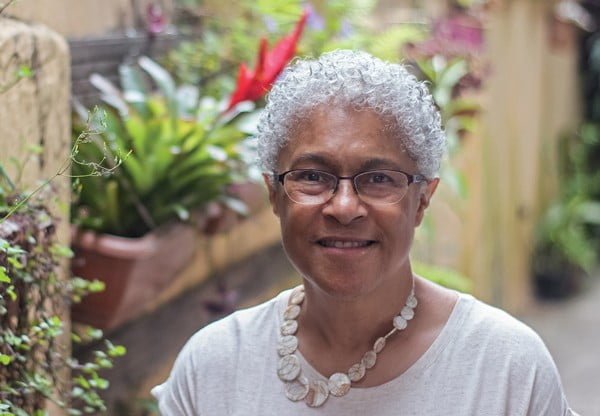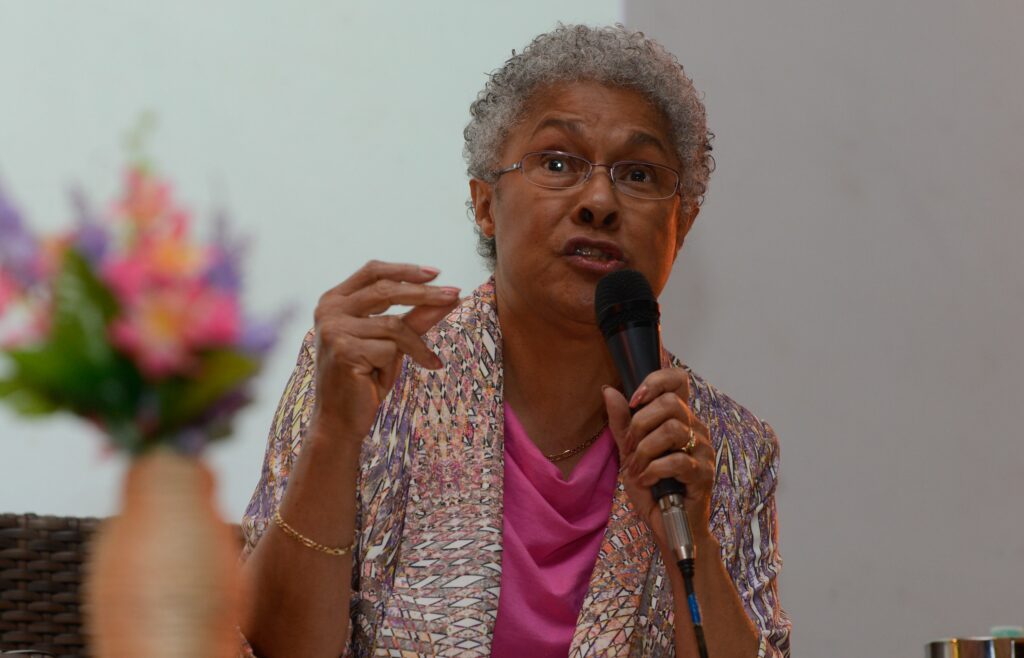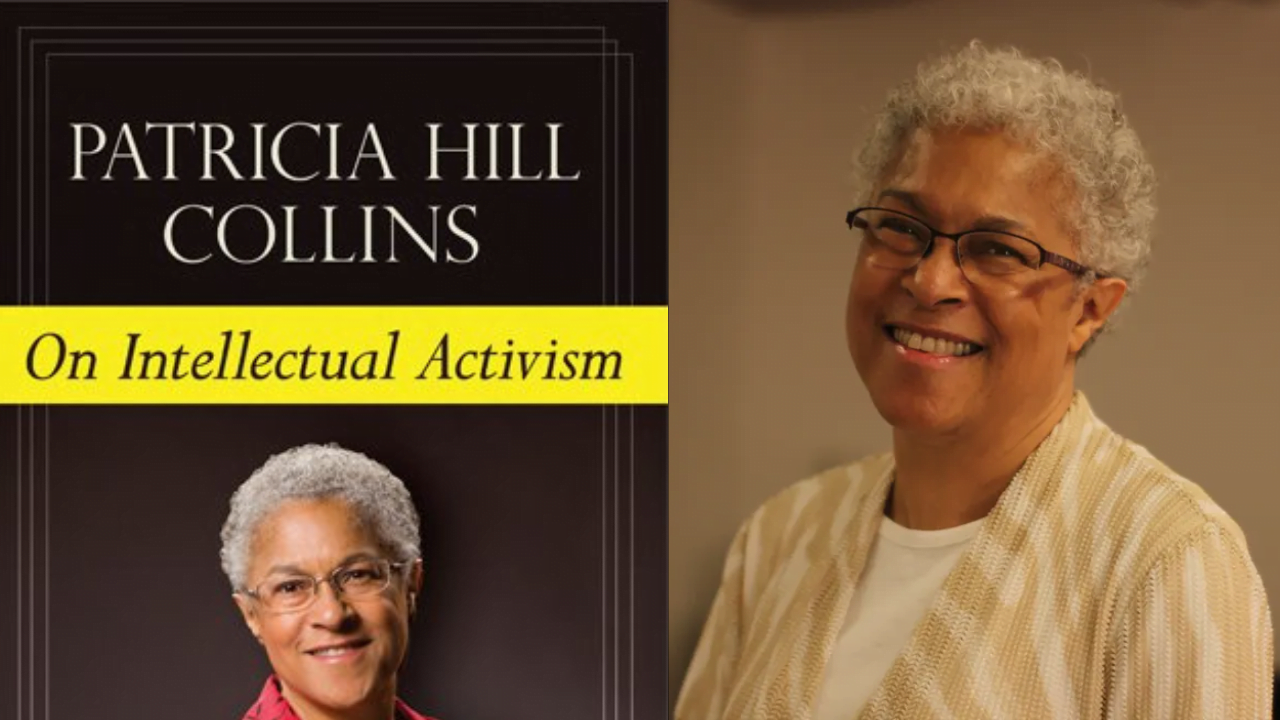On Intellectual Activism constitutes a series of essays derived from decades-worth of scholarship by Patricia Hill Collins. The book delineates her trajectory of participating in “engaged scholarship,” which is an attempt to bring closer her work in academia to the public, her knowledge-creation concerns. Distinguishing between scholarship in support of social justice and scholarship in service to social justice, she firmly places her life’s work within the latter tradition.
While the former brand of scholarship is limited to critiquing conditions that engender social injustices, scholarship in service to social justice through oppositional language represents active participation and accountability on the part of the scholar in eliminating them. The notion of ‘knowledge for knowledge’s sake,’ is rejected in favour of the application of intellectual work in the real world.
The collection of essays in the volume demonstrates the motivations and main arguments presented in Patricia Hill Collins’s most significant works and enables the readers to identify important themes running through them. The volume is divided into five sections, all of which deal with different sites of Hill Collins’s activism.
Presenting the theory of intersectionality, proposing new ways to analyse social injustices, substantiating her arguments through examples from her practice as a scholar and a teacher, and articulating shifts in power relations through systems of domination, such as racism and sexism, Hill Collins puts forth a description of her life’s work through this volume.
The first section refutes the idea of the “objectivity,” of knowledge through an illustrative metaphor: The white man occupies the stage and all other people of different races, gender, ethnicity, citizenship, sexuality, and ability become props to uphold the dominant narrative: until one day, the props start speaking. This shows that knowledge is very much a product of knowledge-makers, and hence, privileged or dismissed according to the position of the knowledge-maker.
Patricia Hill Collins’s distinctive standpoint of the world is shaped by her experiences as an African American woman brought up in a working-class family. Her experiences as a Black woman and what she was taught as a part of her public school curriculum couldn’t have been more at odds: the white man’s narrative – his knowledge – erased the experiences of the “others.”
This led to the writing of Black Feminist Thought, the first, full-fledged treatment of the theory of intersectionality. She put forth the idea that power is relational, and hence, domination of oppressed persons should be analysed as such. The relationality of power rejects the either/or binary of categorising people into someone who is either oppressed or is an oppressor.
Instead, it proposes that people become oppressors and oppressed according to how they are placed within the intersecting systems of power based on their multiple identities. Black Sexual Politics was an extension of Black Feminist Thought. The essay on Black Sexual Politics provides a thorough analysis of the complex web of gendered and racialised power relations that produced images of Black people and categorised them as gender outlaws and sexual deviants in relation to the white heterosexual Christian male ideal.
Figures like the asexual “Mammy,” or “Uncle Tom,” figure or the “weak men and strong women,” stereotype as opposed to the “normal,” patriarchal norm of strong men and subordinate women play a significant role in maintaining the “inferiority,” of Black people.
The second section is a foray into Patricia Hill Collins’s position as an “outsider-within,” in academia. She argues that scholarship written from border spaces such as hers is instructive since it can ‘draw on a creative tension of being on the margins within intersecting systems of race, class, gender, sexual, and national oppression.’
She criticises the appropriation of the outsider-within positions by elite scholars that essentially strips such spaces off their historical contexts. It reduces such spaces to that of an individual, ignoring the social hierarchies that result in positions of outsider-within.
The essays in this section discuss the field of Public Sociology which categorises the kind of work she had been doing for a long time. She speculates on the consequences of Public Sociology’s institutionalisation—while it may elevate the field, it can also result in what other border disciplines have suffered after their institutionalisation: ‘Public sociology can easily become yet another fad, a nugget of commodified knowledge that privileged sociologists can play at, just as a cat toys with a mouse. What comforting procrastination-one remains ethically honourable by paying lip service to public sociology while never having to take a stand by actually doing it.’
In another essay, Hill Collins critiques the urge to view Sociology as a rigid field with clearly defined boundaries, hampering the potential of interdisciplinary work that it is capable of. Harking back on the “golden years,” of sociology, many scholars bemoan diverse books and research produced in recent years in the field of sociology. These golden years represented an age when there was a definitive list of sociology texts written by a privileged, homogenous group of white men.
Patricia Hill Collins defends these new developments affirming the need for acceptance since Sociology’s speciality—its sophisticated methodologies—lies in its capacity to accommodate the kind of interdisciplinary research that will be required for today’s globalised and interconnected world to explain complex social phenomena. Its isolation will only serve as an ossifying measure for the field.
The third section of the book concerns the need for critical education for the youth to enable them to develop a critical consciousness and think for themselves. Patricia Hill Collins’s years as a middle school teacher at St. Joseph’s Community School and professor at the University of Cincinnati are demonstrative of her attempts to achieve a synergy between her scholarship and activism: ‘I saw my intellectual production as tethered to a broader commitment to intellectual activism whereby my engaged scholarship and critical pedagogy shaped one another.‘

What becomes central to critical education is a transformation in the curriculum that is inclusive and aims to empower Black people and a pedagogy that involves active participation in knowledge-creation on the part of the students; they cannot remain passive recipients of knowledge. Learning how to question, maintaining a dialogue with a heterogeneous group of people, and being receptive to different standpoints resulting from differences in gender, race, class and other social systems are all possible inside the classroom. This makes the classroom a very political space.
In the section “Racial Politics,” Hill Collins discusses the change between the racism of the past and contemporary racism. Contemporary racism is typically colourblind (“I don’t see colour,”) and a belief that we live in a “post-racial” world: racism is a thing of the past. She calls for thorough analyses of race relations that will have to include the altered nature of the “colour line.”
Racism is no longer defined by the white/black binary. Instead, it has taken a much more complex form owing to the absence of overt forms of racism and increasing populations of other groups (Latinos, Asian Americans, Native Americans, Etc.) who experience racism in different ways.
Like in all her other work, Patricia Hill Collins reiterates the need for new frameworks and complex analyses of these shifting race relations in contrast to the assertion by liberals and conservatives alike that we live in a “post-racial,” world. She proposes a new framework through which race relations could be analysed. She delineates four domains of power through which racism operates: structural, disciplinary, cultural, and interpersonal.

Some domains of power tended to hold prominence in the colour-conscious racism of the past (structural and interpersonal domains), however, contemporary racism can be explained better through the increasing influence of other domains (such as the cultural and disciplinary domains).
In the essay “The Ethos of Violence,” Hill Collins critiques the very definition of violence. For instance, intimidation tactics and verbal abuse are not violence but the physical act of hitting someone is: she criticises this separation of speech and act, even though the former can be extremely violent (“You are worthless,”). The degree of severity of violence is, more often than not, judged based on the identity of the victim instead of the act itself.
For example, A white woman raped in a prison cell receives significant protection, while black women who are sex workers are “impossible,” to rape. White heterosexual men would be stigmatised and labelled as effeminate and weak if raped. Violence against Black people today also has taken new forms: while these violent acts are not as severe as lynching, they manifest themselves in the form of micro-assaults. Being repeatedly stopped by the police is one such micro-assault, which assumes that African American men are always suspect.
The gendered and racialised nature of violence becomes normalised and hence, natural: such acts of violence are invisible because they are so routine. The last section of the book (which won’t be discussed at length here) can be viewed as an articulation of distinctive ideas that motivates all her work.
The essays in the book are well-structured, substantiated, and written in the kind of language that is direct and devoid of jargon. What is striking is Patricia Hill Collins’s intellectual and emotional investment in the scholarship she has produced. The sheer breadth of experiences, practicable approaches she offers for social issues (such as the building of coalitional communities based on democratic principles), and her dedication to involving people that her scholarship concerns make this an inspiring read for anyone who deeply wishes to work for a more just world.
Note: Discussion on many themes and essays in the collection have been excluded owing to the wealth of information, themes, and issues the book addresses, which cannot be accommodated in this review.
About the author(s)
Shakti (she/her) is an English major and an aspiring tea sommelier. She loves reading poetry and drama and can be found with a Kindle most time. She intends to become a teacher of humanities and is passionate about literature, films, politics, and history. In her free time, she has been caught watching cringe content, however, she fervently denies these claims.







The text is difficult to read due to confusing punctuation and paragraph separation. Inappropriate use of double quotations and commas makes it unclear whether they should be read together or separately.
Example:
maintaining the “inferiority,” of Black people.
“post-racial,” world
I also feel that the flow of ideas is disrupted as unnecessary new paragraphs are introduced, while it would have been better to continue in the previous paragraph.